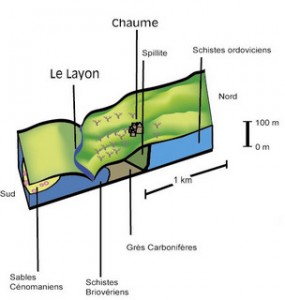Quarts de Chaume dissected

http://www.vinsdeloire.fr/SiteGP/FR/Appellation/Appellation/Quarts-de-Chaume
Due south, across the river, of new Loire appellations Roches aux Moines and Coulée de Serrant in Savennières, lies Quarts de Chaume, recently elevated to grand cru status. Claude Papin of Château Pierre Bise explained its origins.
The appellation is situated on the right bank of Loire tributary, the river Layon, as it wends its way in a north-westerly direction, to join the Loire at Chalonnes-sur-Loire.
The new grand cru is a 43 hectare enclave within the 1,400 ha Coteaux du Layon appellation. Its peculiarity is that it is an outcrop of carboniferous sandstone and Britanny schist that’s higher than the rest of the slope, and nearer to the river, which means it gets “less wind, more sun and more mists” said Claude Papin. He said Layon “is the geological frontier between Brittany and Anjou, an area where there was a lot of movement. At the bottom of the slope is Breton schist, which is normally on the left bank, but here is on the right bank.”
Three geological formations influence the appellation. Around 250 million years ago, Papin said “the left bank went down and the right bank came up in a fault, creating carboniferous rifts. There was a tropical climate at the time as the land was around the equator. Volcanic ash, dust, trees accumulated” in huge hollows, which is now coal.
Between 250 million years and 6 million years ago the Britanny schist was created by compression from the depth of sea above, and volcanic heat. Finally, from 6 million years ago, when the area was still under the sea, this Britanny schist was fracturing, creating “30 to 50 km deep volcanic fissures, through which lava arrived” said Papin, adding that Pierre Bise is on an epicentre of lava flow.
Papin said a typical Quarts de Chaume expression “shows aromatic finesse, is marked by botrytis and has a balance between the mineral and citrus quality, and botrytis.” Any concentration should arrive by natural means as chaptalisation, reverse osmosis and cryo-extraction are all forbidden by the appellation. “Most are vinified in oak” he said, “though not new, and there is no malolactic fermentation in Quarts de Chaume.”
Different expressions are argued to arise from the underlying bedrock, whether on Brittany schist, close to the river, on the carboniferous outcrop, or volcanic soils of the mid-slope. For example, Papin said a ginger note is typical of volcanic soils. A unifying feature is botrytis.
The 14 producers in Quarts de Chaume produce a total of between 5,000 and 8,000 cases a year.
My research visit to the Loire in August 2011 was sponsored by InterLoire.



